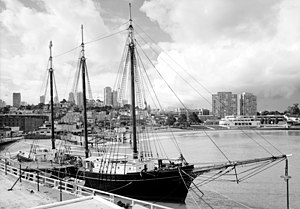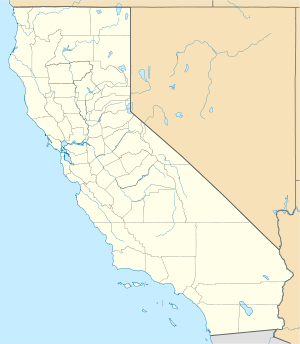C.A. Thayer (1895)

C.A. Thayer in 1988
|
|
| History | |
|---|---|
|
|
|
| Namesake: | Clarence A. Thayer |
| Launched: | 1895 |
| Out of service: | c.1950 |
| Status: | Museum ship |
| General characteristics | |
| Tonnage: | 453 (gross) |
| Length: | 219 ft (67 m) |
| Beam: | 36 ft (11 m) |
| Depth of hold: | 11.38 ft (3.47 m) |
|
C.A. Thayer
|
|

C.A. Thayer, launched November 12, 1895
|
|
| Location | San Francisco, California |
| Coordinates | 37°48′33″N 122°25′18″W / 37.80917°N 122.42167°WCoordinates: 37°48′33″N 122°25′18″W / 37.80917°N 122.42167°W |
| Area | Eureka, California |
| Built | 1895 |
| NRHP Reference # | 66000229 |
| Significant dates | |
| Added to NRHP | 13 November 1966 |
| Designated NHL | 13 November 1966 |
C.A. Thayer is a schooner built in 1895 near Eureka, California. The schooner is now preserved at the San Francisco Maritime National Historical Park. She is one of the last survivors of the sailing schooners in the West coast lumber trade to San Francisco from Washington, Oregon, and Northern California. She was added to the National Register of Historic Places on 13 November 1966.
This ship is used for many class field trips.
C.A. Thayer was built by Danish-born Hans Ditlev Bendixsen in his shipyard, located across the narrows of Humboldt Bay from the city of Eureka in Northern California. Bendixsen also built the Wawona (1897) which was dismantled in 2009. The C.A. Thayer was named for Clarence A. Thayer, a partner in the San Francisco-based E.K. Wood Lumber Company.
Between 1895 and 1912, C.A. Thayer usually sailed from E.K. Wood's mill in Grays Harbor, Washington, to San Francisco. But she also carried lumber as far south as Mexico, and occasionally even ventured offshore to Hawaii and Fiji.
C.A. Thayer is typical of the sort of three-masted schooners often used in the west coast lumber trade. She is 219 feet (67 m) in length and has a cargo capacity of 575,000 board feet (47,900 cu ft; 1,360 m3). She carried about half of her load below deck, with the remaining lumber stacked 10 feet (3.0 m) high on deck. In port, her small crew of eight or nine men were also responsible for loading and unloading the ship. Unloading 75,000 to 80,000 board feet (6,300 to 6,700 cu ft; 180 to 190 m3) was an average day's work.
...
Wikipedia

